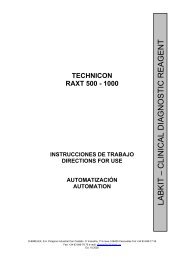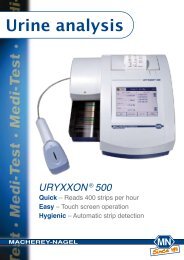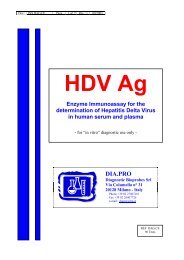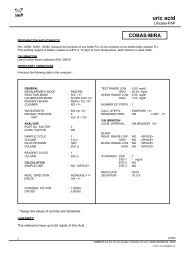[APTT-SiL Plus]. - Agentúra Harmony vos
[APTT-SiL Plus]. - Agentúra Harmony vos
[APTT-SiL Plus]. - Agentúra Harmony vos
You also want an ePaper? Increase the reach of your titles
YUMPU automatically turns print PDFs into web optimized ePapers that Google loves.
Instructions For Use<strong>APTT</strong>-<strong>SiL</strong> <strong>Plus</strong>REF 5560, 5561<strong>APTT</strong>-<strong>SiL</strong> <strong>Plus</strong>Fiche technique<strong>APTT</strong>-<strong>SiL</strong> <strong>Plus</strong>Anleitung<strong>APTT</strong>-<strong>SiL</strong> <strong>Plus</strong>Istruzioni per l’uso<strong>APTT</strong>-<strong>SiL</strong> <strong>Plus</strong>Instrucciones de usoContentsEnglish 1Français 5Deutsch 9Italiano 13Español 17
INTENDED USEThe Activated Partial Thromboplastin Time (<strong>APTT</strong>) test is used principally to detect deficiencies in theStage I Factors, namely Factors VIII, IX, XI and XII. From its origins through the work of Langdell andcoworkers 1 , and later modified by others 2,3 , the Activated Partial Thromboplastin Time test has beenwidely used for a number of years as a pre-surgical screen for assessing certain coagulation factors andin monitoring Heparin therapy. All Factors of the Intrinsic Pathway are necessary for normal resultswhen performing the <strong>APTT</strong> test.The <strong>APTT</strong> test is also used to monitor Heparin (UFH) therapy, showing prolonged test results atapproximately 0.1 units/ml and above 5 .The test is also used in the quantitative determination (Factor Assays) of Factors VIII, IX, XI, XII.The <strong>APTT</strong> test measures the clotting time of test plasma. An initial activation of the <strong>APTT</strong> reagent withthe test plasma is followed by the addition of calcium chloride and the clotting time is measured inseconds. Deficiencies of approximately 40% and lower of Factors VIII, IX, XI and XII will result in aprolonged <strong>APTT</strong>. Heparin, in the presence of adequate amounts of AT-III will also result in aprolonged <strong>APTT</strong>.WARNINGS AND PRECAUTIONSAll wastes containing biological material should be properly labelled and stored separately from otherwastes. Dispose of all waste materials according to prescribed international, national and localregulations.The test should be used in conjunction with clinical observations and results of other laboratory tests.COMPOSITIONREF 5560 (5 x 10ml <strong>APTT</strong>-<strong>SiL</strong> <strong>Plus</strong> Reagent + 5 x 10ml 25mM Calcium Chloride)REF 5561 (10 x 10ml <strong>APTT</strong>-<strong>SiL</strong> <strong>Plus</strong> Reagent + 10 x 10ml 25mM Calcium Chloride)<strong>APTT</strong>-<strong>SiL</strong> <strong>Plus</strong> reagent contains a near-collodial particle activator (magnesium-aluminum-silicate) foroptimum sensitivity to Factor deficiencies and to Heparin. The Reagent also contains phospholipidswith buffer and stabilizers.Preparation for use:Reconstitute each vial with 10ml of distilled or dionised water. Swirl gently. Allow to stand for 10minutes for complete dissolution and mix well before use.STORAGE AND STABILITYStore at 2...8°C. Do not freeze.Stable for 30 days after opening. Avoid prolonged heating.<strong>APTT</strong>-<strong>SiL</strong> <strong>Plus</strong>1English
SAMPLE COLLECTION AND PREPARATIONA. Anticoagulant. Use buffered sodium citrate 3.2%.B. Specimen Collection 61. Obtain venous blood by clean venipuncture.2. Immediately mix nine parts blood with one part anticoagulant, mix well by inversion of tube againstthe stopper.3. Centrifuge the specimen at 1500 x g for no less than 15 minutes.4. Remove plasma from the tube within 60 min using a plastic pipette and store in a plastic tube.5. Test plasma sample within 4 hours, otherwise store frozen at -20°C for up to two weeks or -70°Cfor up to six months 6 and thaw once just prior to use.STEP-BY-STEP PROCEDUREA. Materials Provided:1. <strong>APTT</strong>-<strong>SiL</strong> <strong>Plus</strong> (lyophilised)2. 0.025 M Calcium chlorideB. Materials Required:1. A manual, mechanical or photo-optical means of clot detection.2. Suitable timer.3. Parafilm or equivalent.4. Precision pipettor, 0.1 ml.5. Control Plasmas.C. Performance of TestThe use of <strong>APTT</strong>-<strong>SiL</strong> <strong>Plus</strong> in the performance of <strong>APTT</strong> determinations is adaptive to manual orautomated instruments for clot detection. See instrument manufacturers instructions for full details.1. Prewarm well mixed <strong>APTT</strong>-<strong>SiL</strong> <strong>Plus</strong> and 0.025 M Calcium Chloride to 37°C.2. Prewarm 0.1 ml test plasma in duplicate to 37°C for 2 minutes.3. Forcibly add 0.1 ml prewarmed <strong>APTT</strong>-<strong>SiL</strong> <strong>Plus</strong> to plasma and start timer.4. Incubate for exactly 5 minutes at 37°C.5. Add 0.1 ml prewarmed 0.025 M Calcium Chloride.6. Note time for clot formation.7. Report result as <strong>APTT</strong> time (seconds).D. Automated Methods, AC-4. (5560 x1000 samples, 5561 x2000 samples)Refer to the appropriate AC-4 Operators Manual for detailed instructions.Prepare all reagents as instructed under 'composition'.START=17s METHOD=Coag MIX=0 PATIENT(Pat)vol=50µLpos=35 (CP)INCUB=300s MATH=lin CLEAN=0 BUFFER (BUF)Vol=0µLDef. Plasma (DP)Vol=0µLR1Vol=50µLPos=31RUNTIME=180s SENS=1 T-CORR=0S-CORR=0CLEAR (CLR)Vol=0µLR2Vol=50µLPos=262
INTERPRETATION OF RESULTSCalculate the mean clotting time of duplicate determinations for each test plasma and Control Plasmas.The difference between duplicate determinations should not exceed 5% (repeat if necessary).Report the <strong>APTT</strong> time result in seconds along with the Normal Range.Control Plasmas are to be used to help assure that test variables, such as temperature, reagents,instrumentation, pipettes, etc. are functioning properly. It is not recommended that Control values bereported with patient results.QUALITY CONTROLHelena Normal and Abnormal Coagulation Control Plasmas should be tested in conjunction withpatient samples. It is recommended that at least one Normal and one Abnormal be run at each shift.A Control Range should be established by the laboratory to determine the allowable variation in dayto day performance of each Control Plasma.EXPECTED VALUESTypical Normal results using Helena <strong>APTT</strong>-<strong>SiL</strong> <strong>Plus</strong> are approximately 35-45 seconds. However, eachlaboratory should establish its own Normal Range using the reagents, instrumentation and techniquescommonly in use in the laboratory. A Normal Range should be established using individualsrepresentative of the population being tested within the laboratory.A new Normal Range should be established with any change in instrumentation, blood collectiontechniques, anticoagulant and when changing to new lots of reagents.LIMITATIONSGreat care must be taken to minimize variations which may occur by seemingly insignificant factors.A. Specimen Collection.AVOID:1. Use of glass. Use only plastic.2. Delayed mixing of blood with anticoagulant.3. Hemolysis or lipemic samples.4. Contamination with tissue thromboplastin.5. Improper ratio of anticoagulant with blood.B. Laboratory Techniques1. Perform tests at 37°C.2. Use only high purity water.3. Optimum pH is 7.0-7.5<strong>APTT</strong>-<strong>SiL</strong> <strong>Plus</strong>3English
PERFORMANCE CHARACTERISTICSHelena BioSciences or their representatives have determined the following performancecharacteristics as a guideline. Each laboratory should establish it's own performance data.Precision StudiesResults are shown below:Within Run (aPTT in seconds): Precision studies were performed in replicate on the SysmexCA1500 using two levels of control materials.Control Mean C.V. NNorm-Trol 1 41.8 0.41% 10Ab-Trol 3 70.0 0.87% 10Between Run (aPTT in seconds): Precision studies were performed in the same manner using twolevels of control material during three runs for evaluation.Control Mean C.V. NNorm-Trol 1 41.81 1.16% 100Ab-Trol 3 67.5 4.72% 100REFERENCES1. Langdell, R., Wagner, R., Brinkhous, K.: Effect of Antihemophilic Factor on One Stage ClottingTests. J. Lab. Clin. Med. 41: 637, 1953.2. Proctor, R., Rapaport, S.: The Partial Thrombopastin Time with Kaolin. Am. J. Clin. Path. 36: 212,1961.3. Ratnoff, O., Crum, S.: Activation of Hageman Factor by Solutions of Ellagic Acid. J. Lab. Clin. Med.63: 359, 1964.4. Hathaway, W., Clarke, S., Christian, M., Jacobson, L.: Sensitivity of the Activated PartialThromboplastin Time to Mild Factor Deficiencies; in Standardization of Coagulation Assays: AnOverview. College of American Pathologists, Skokie, IL. pp. 131, 1982.5. Brandt, J., Triplett, D.: Laboratory Monitoring of Heparin. Effect of Reagents and Instruments inthe Activated partial Thromboplastin Time. Am. J. Clin. Path. 76: 530, 1981.6. CLSI: Guidelines for the Standardized Collection, Transport and Preparation of Blood Specimensfor Coagulation Testing and Performance of Coagulation Assays. H21-A4.4
UTILISATIONLe dosage <strong>APTT</strong> sert avant tout à détecter les déficits en facteurs de premier niveau, à savoir lesfacteurs VIII, IX, XI et XII. Dès le début, avec les travaux de Langdell et de ses associés 1 , plus tardmodifiés par d'autres chercheurs 2,3 , le test du temps de céphaline activée a été couramment employépendant plusieurs années pour le dépistage préopératoire de certains facteurs de coagulation et dansle suivi des traitements à l'héparine. Tous les facteurs de la voie endogène sont requis pour obtenir desrésultats normaux dans les tests <strong>APTT</strong>.Les tests <strong>APTT</strong> servent également à suivre le traitement à l'héparine (HNF) en faisant apparaître desrésultats prolongés à environ 0,1 unité/ml et au-delà 5 .Ils sont également utilisés pour l'analyse quantitative (titrages de facteur) des facteurs VIII, IX, XI, XII.Le test <strong>APTT</strong> mesure le temps de coagulation du plasma à analyser. L'activation initiale du réactif <strong>APTT</strong>avec le plasma en question est suivie par l'ajout de chlorure de calcium ; le temps de coagulation estmesuré en secondes. Les déficits inférieurs ou à peu près égaux à 40 % en facteurs VIII, IX, XI et XIIdonneront un <strong>APTT</strong> prolongé. En présence d'une quantité appropriée d'AT III, l'héparine donnera elleaussi un <strong>APTT</strong> prolongé.PRÉCAUTIONSTous les déchets contenant des matériaux biologiques doivent être étiquetés en conséquence et nedoivent pas être stockés avec les déchets d'autre type. Éliminez tous les déchets conformément auxrèglements internationaux, nationaux et locaux.L'analyse doit être menée en association avec les observations cliniques et d'autres analyses delaboratoire.COMPOSITIONREF 5560 (5 x 10ml <strong>APTT</strong>-<strong>SiL</strong> <strong>Plus</strong> Réactif + 5 x 10ml 25mM chlorure de calcium)REF 5561 (10 x 10ml <strong>APTT</strong>-<strong>SiL</strong> <strong>Plus</strong> Réactif + 10 x 10ml 25mM chlorure de calcium)Le réactif <strong>APTT</strong>-<strong>SiL</strong> <strong>Plus</strong> contient un activateur à particules semi-colloïdales (magnésium-aluminiumsilicate)pour une sensibilité optimale aux déficits de facteurs et à l'héparine. Le réactif contient aussi lephospholipide avec le tampon et les agents de stabilisation.Préparation du réactifReconstituer chaque flacon avec 10ml d'eau distillée ou désionisée. Agiter doucement. Attendre 10minutes jusqu'à dissolution totale et bien mélanger avant d'utiliser.STOCKAGE ET CONSERVATIONConservez-le à 2...8°C sans le congeler.Stable pendant 30 jours après ouverture. Évitez des réchauffements prolongés.PRÉLÈVEMENT DES ÉCHANTILLONSA. Anticoagulant. Utilisez la solution tampon de citrate de sodium, 3,2 %.B. Prélevez l'échantillon (voir, par exemple, les directives CLSI, réf. 6)<strong>APTT</strong>-<strong>SiL</strong> <strong>Plus</strong>5Français
1. Prélevez des spécimens sanguins veineux par ponction veineuse aseptique.2. Versez immédiatement neuf volumes de sang et un volume d'anticoagulant, mélangez bien enrenversant le tube sur le bouchon.3. Centrifugez le spécimen à 1500 x g pendant au moins 15 minutes.4. Retirez le plasma du tube dans les 60 minutes en utilisant une pipette en plastique et conservez-ledans un tube en plastique.5. Testez les échantillons dans les 4 heures ou congelez-les à -20°C pendant un maximum de deux semaines,ou à -70°C pendant un maximum de six mois 6 ; décongelez une seule fois, juste avant utilisation.MÉTHODOLOGIEA. Matériaux fournis1. <strong>APTT</strong>-<strong>SiL</strong> <strong>Plus</strong> (lyophilisé)2. Chlorure de calcium à 0,025 MB. Matériaux requis :1. Un dispositif de détection manuelle, mécanique ou photo-optique des caillots.2. Coagulomètre adapté3. Parafilm ou équivalent4. Pipette de précision, 0,1 ml5. Plasmas de contrôleC. Exécution du testL'utilisation des tests <strong>APTT</strong>-<strong>SiL</strong> <strong>Plus</strong> doit être adaptée pour exécuter les analyses <strong>APTT</strong> selon que lesdispositifs de détection de caillots sont manuels ou automatiques. Voir les instructions du fabricant dudispositif utilisé pour les détails.1. Préchauffez le mélange d'<strong>APTT</strong>-<strong>SiL</strong> <strong>Plus</strong> et de chlorure de calcium à 0,025 M à 37°C.2. Préchauffez 0,1 ml de plasma à analyser, en dosage double, à 37°C pendant 2 minutes.3. Ajoutez énergiquement 0,1 ml d'<strong>APTT</strong>-<strong>SiL</strong> <strong>Plus</strong> préchauffé au plasma et lancez le coagulomètre.4. Laissez incuber pendant 5 minutes exactement à 37°C.5. Ajoutez 0,1 ml de chlorure de calcium à 0,025 M préchauffé.6. Notez le temps de formation de caillots.7. Exprimez les résultats <strong>APTT</strong> en secondes.D. Méthodes automatisées, AC-4. (5560 x1000 échantillons, 5561 x2000 échantillons)Se conformer au manuel d'utilisation de AC-4 correspondant pour avoir des instructions détaillées.Préparer tous les réactifs en suivant les indications du paragraphe CompositionSTART=17s METHOD=Coag MIX=0 PATIENT(Pat)vol=50µLpos=35 (CP)INCUB=300s MATH=lin CLEAN=0 BUFFER (BUF)Vol=0µLDef. Plasma (DP)Vol=0µLR1Vol=50µLPos=31RUNTIME=180s SENS=1 T-CORR=0S-CORR=0CLEAR (CLR)Vol=0µLR2Vol=50µLPos=266
INTERPRÉTATION DES RÉSULTATSCalculez le temps moyen de coagulation des analyses en double dosage pour chaque échantillon testéet plasma de contrôle. La différence entre les dosages doubles ne doit pas excéder les 5 % (répétez letest si nécessaire). Notez le temps <strong>APTT</strong> en secondes parallèlement à l'échelle de valeurs normale.Les plasmas de contrôles doivent servir à garantir que les variables du type températures, réactifs,instruments, pipettes, etc. fonctionnent correctement. Nous ne recommandons pas d'attacher lesvaleurs de contrôle aux résultats enregistrés pour le patient.CONTRÔLE QUALITÉOn devra analyser des plasmas de contrôle Helena de coagulation normaux et anormaux parallèlementaux échantillons de patients. Nous recommandons d'utiliser au moins un contrôle normal et un autreanormal pour chaque série.Une fourchette de valeurs de contrôle doit être établie pour chaque laboratoire afin d'établir les tauxpermissibles de variation dans l'exécution quotidienne de chaque plasma de contrôle.VALEURS DE RÉFÉRENCELes résultats normaux types avec le réactif Helena <strong>APTT</strong>-<strong>SiL</strong> <strong>Plus</strong> sont d'environ 35-45 secondes.Chaque laboratoire doit toutefois établir ses propres normes en utilisant les réactifs, instruments ettechniques utilisés sur place d'ordinaire. Les normes doivent être établies en utilisant des individusreprésentatifs de la population testée dans le laboratoire.L'échelle de normes doit être vérifiée à chaque changement d'instruments, de techniques deprélèvements sanguins, d'anticoagulant ou de lots de réactifs.LIMITESOn devra prendre grand soin de minimiser les variations qui pourraient résulter de facteursapparemment insignifiants.A. Prélèvement des échantillonsÉVITER :1. Usage du verre. N'utilisez que du plastique.2. Retard dans le mélange du sang avec l'anticoagulant.3. Échantillons hémolytiques ou lipémiques.4. Contamination avec thromboplastine tissulaire.5. Taux incorrects d'anticoagulant par rapport au sang.B. Techniques de laboratoire1. Effectuez les tests à 37ºC.2. N'utilisez que de l'eau hautement purifiée.3. Le pH optimal est de 7,0 - 7,5.<strong>APTT</strong>-<strong>SiL</strong> <strong>Plus</strong>7Français
PERFORMANCESHelena BioSciences ou ses représentants ont déterminé à titre indicatif les performances suivantes.Chaque laboratoire doit établir ses propres données de performance.Études de précisionLes résultats sont indiqués ci-dessous :Intra-analyse (<strong>APTT</strong> en secondes) : Des études de précision ont été réalisées en double enanalysant avec l’automate Sysmex CA1500 deux contrôles offrant des TCA différents.Control Mean C.V. NNorm-Trol 1 41.8 0.41% 10Ab-Trol 3 70.0 0.87% 10Inter-analyses (<strong>APTT</strong> en secondes) : Des études de précision ont été réalisées dans la même façonà l’aide de deux contrôles offrant des TCA différent qui ont été analysés trois fois.Control Mean C.V. NNorm-Trol 1 41.81 1.16% 100Ab-Trol 3 67.5 4.72% 100BIBLIOGRAPHIE1. Langdell, R., Wagner, R., Brinkhous, K.: Effect of Antihemophilic Factor on One Stage ClottingTests. J. Lab. Clin. Med. 41: 637, 1953.2. Proctor, R., Rapaport, S.: The Partial Thrombopastin Time with Kaolin. Am. J. Clin. Path. 36: 212,1961.3. Ratnoff, O., Crum, S.: Activation of Hageman Factor by Solutions of Ellagic Acid. J. Lab. Clin. Med.63: 359, 1964.4. Hathaway, W., Clarke, S., Christian, M., Jacobson, L.: Sensitivity of the Activated PartialThromboplastin Time to Mild Factor Deficiencies; in Standardization of Coagulation Assays: AnOverview. College of American Pathologists, Skokie, IL. pp. 131, 1982.5. Brandt, J., Triplett, D.: Laboratory Monitoring of Heparin. Effect of Reagents and Instruments inthe Activated partial Thromboplastin Time. Am. J. Clin. Path. 76: 530, 1981.6. CLSI: Guidelines for the Standardized Collection, Transport and Preparation of Blood Specimensfor Coagulation Testing and Performance of Coagulation Assays. H21-A4.8
VERWENDUNGSZWECKDer Test zur Bestimmung der aktivierten partiellen Thromboplastinzeit (<strong>APTT</strong>) dient hauptsächlichzum Nachweis von Mangelzuständen der Faktoren der Phase I, insbesondere der Faktoren VIII, IX, XIund XII. Der <strong>APTT</strong>-Test wurde durch die Arbeit von Langdell und Mitarbeitern konzipiert 1 und späterdurch andere modifiziert 2,3 . Seit etlichen Jahren wird er breitläufig bei der präoperativen Ermittlunggewisser Gerinnungsfaktoren und bei der Überwachung der Heparintherapie angewendet. Um mitdem <strong>APTT</strong>-Test normale Ergebnisse zu erhalten, sind alle Faktoren des intrinsischenGerinnungssystems erforderlich.Der <strong>APTT</strong>-Test wird auch zur Überwachung einer Heparin (UFH)-Therapie eingesetzt. Hier ergebensich verlängerte Testergebnisse von etwa 0,1 Einheiten/ml und mehr 5 .Weiterhin dient der Test zur quantitativen Bestimmung (Faktortests) der Faktoren VIII, IX, XI, XII.Beim <strong>APTT</strong>-Test wird die Gerinnungszeit des Testplasmas gemessen. Nach einer anfänglichenAktivierung des <strong>APTT</strong>-Reagenzes mit dem Testplasma folgt die Zugabe von Kalziumchlorid;die Gerinnungszeit wird in Sekunden gemessen. Ein Mangel von etwa 40% oder mehr an den FaktorenVIII, IX, XI und XII führt zu einer verlängerten <strong>APTT</strong>. Heparin führt bei Vorhandensein entsprechenderMengen von AT-III ebenfalls zu einer verlängerten <strong>APTT</strong>.WARNHINWEISE UND VORSICHTSMASSNAHMENAlle Abfälle, die biologisches Material enthalten, müssen ordnungsgemäß gekennzeichnet und vonanderem Abfall getrennt gelagert werden. Entsorgen Sie alle Abfälle unter Beachtung dervorgeschriebenen internationalen, nationalen und örtlichen Bestimmungen.Der Test muss in Zusammenhang mit klinischen Beobachtungen und den Ergebnissen andererLabortests betrachtet werden.INHALTREF 5560 (5 x 10ml <strong>APTT</strong>-<strong>SiL</strong> <strong>Plus</strong> Reagenz + 5 x 10ml 25mM Kalziumchlorid)REF 5561 (10 x 10ml <strong>APTT</strong>-<strong>SiL</strong> <strong>Plus</strong> Reagenz + 10 x 10ml 25mM Kalziumchlorid)<strong>APTT</strong>-<strong>SiL</strong> <strong>Plus</strong>Das Reagenz <strong>APTT</strong>-<strong>SiL</strong> <strong>Plus</strong> enthält einen Aktivator aus nahezu kolloiden Partikeln (Magnesium-Aluminium-Silikat), mit dem eine optimale Sensitivität gegenüber Faktor-Mangelzuständen und Heparinerreicht wird. Außerdem enthält das Reagenz phospholipid mit Puffer und Stabilisatoren.ReagenzvorbereitungJedes Fläschchen mit 10ml destilliertem oder entionisiertem Wasser rekonstituieren. Leichtschwenken. Zum vollständigen Auflösen 10 Minuten stehen lassen und vor Gebrauch gut mischen.LAGERUNG UND STABILITÄTBei 2...8 °C lagern. Nicht einfrieren.Das Produkt ist nach dem Öffnen 30 Tage lang stabil. Vermeiden Sie lang andauerndes Erhitzen.9Deutsch
PROBENENTNAHME UND VORBEREITUNGA. Antikoagulans. Gepuffertes Natriumcitrat von 3,2% verwenden.B. Probensammlung (siehe z.B. die CLSI-Richtlinien, Literaturangabe 6)1. Entnehmen Sie unter sauberen Bedingungen venöses Blut mittels Venenpunktur.2. Versetzen Sie sofort neun Teile Blut mit einem Teil Antikoagulans, und mischen Sie gut, indem Siedas mit einem Stopfen versehene Röhrchen umdrehen.3. Zentrifugieren Sie die Probe mindestens 15 Minuten lang bei 1500 x g.4. Entfernen Sie innerhalb von 60 Minuten das Plasma mit einer Kunststoffpipette aus dem Röhrchenund bewahren Sie es in einem Kunststoffröhrchen auf.5. Testen Sie die Plasmaprobe innerhalb von 4 Stunden; frieren Sie sie andernfalls bis zu zwei Wochenlang bei -20°C oder bis zu sechs Monaten bei -70°C ein 6 , und tauen Sie die Probe nur einmalunmittelbar vor dem Gebrauch auf.SCHRITT-FÜR-SCHRITT METHODEA. Gelieferte Materialien1. <strong>APTT</strong>-<strong>SiL</strong> <strong>Plus</strong> (lyophilisiert)2. 0,025 M KalziumchloridB. Erforderliche Materialien:1. Ein manuelles, mechanisches oder photooptisches Hilfsmittel zum Nachweis von Blutgerinnseln.2. Geeigneter Timer.3. Parafilm oder gleichwertige Vorrichtung.4. Präzisionspipettor, 0,1 ml.5. Kontrollplasmen.C. Durchführung des TestsDie Durchführung von <strong>APTT</strong>-<strong>SiL</strong> <strong>Plus</strong> mit dem <strong>APTT</strong>-Test kann an manuelle und automatischeInstrumente zum Nachweis von Blutgerinnseln angepasst werden. Entnehmen Sie die vollständigenEinzelheiten der Anweisung des Instrumentenherstellers.1. Wärmen Sie gut gemischtes <strong>APTT</strong>-<strong>SiL</strong> <strong>Plus</strong> und 0,025 M Kalziumchlorid auf 37 °C vor.2. Wärmen Sie zwei Proben des Testplasmas von 0,1 ml 2 Minuten lang auf 37 °C vor.3. Geben Sie 0,1 ml vorgewärmtes <strong>APTT</strong>-<strong>SiL</strong> <strong>Plus</strong> zu dem Plasma hinzu, und starten Sie den Timer.4. Inkubieren Sie genau 5 Minuten lang bei 37 °C.5. Fügen Sie 0,1 ml von den vorgewärmten 0,025 M Kalziumchlorid hinzu.6. Notieren Sie die Zeit der Gerinnselbildung.7. Zeichnen Sie das Ergebnis als die <strong>APTT</strong>-Zeit in Sekunden auf.D. Automatisierte Methoden, AC-4. (5560 x1000 Proben, 5561 x2000 Proben)Siehe Bedienungsanleitung des verwendeten Geräts für eine genaue Anleitung.Alle Reagenzien wie unter "Inhalt" beschrieben vorbereiten.START=17s METHOD=Coag MIX=0 PATIENT(Pat)vol=50µLpos=35 (CP)INCUB=300s MATH=lin CLEAN=0 BUFFER (BUF)Vol=0µLRUNTIME=180s SENS=1 T-CORR=0S-CORR=0CLEAR (CLR)Vol=0µLDef. Plasma (DP)Vol=0µLR1Vol=50µLPos=31R2Vol=50µLPos=2610
AUSWERTUNG DER ERGEBNISSEBerechnen Sie die mittlere Gerinnungszeit aus den Doppelbestimmungen für alle Test- undKontrollplasmen. Der Unterschied der Doppelbestimmungen darf 5% nicht überschreiten (nötigenfallswiederholen). Zeichnen Sie das Ergebnis für die <strong>APTT</strong>-Zeit in Sekunden zusammen mit demNormalbereich auf.Die Kontrollplasmen sind dazu vorgesehen, das ordnungsgemäße Funktionieren der Testvariablen,wie der Temperatur, der Reagenzien, Geräte, Pipetten, usw. sicherzustellen. Es wird nicht empfohlen,die Kontrollwerte zusammen mit den Patientenergebnissen anzugeben.QUALITÄTSKONTROLLEZusammen mit den Patientenproben müssen Helena Normale und AnomaleKoagulationskontrollplasmen getestet werden. Es wird empfohlen, in jeder Schicht mindestens einenormale und eine anomale Kontrolle zu testen.Das Labor muss selbst einen Kontrollbereich festlegen, mit dem die zulässige tägliche Abweichung fürjedes Kontrollplasma bestimmt wird.REFERENZWERTEDie typischen mit dem Helena <strong>APTT</strong>-<strong>SiL</strong>-<strong>Plus</strong>-Test erhaltenen Normalwerte liegen etwa zwischen 35und 45 Sekunden. Jedes Labor muss jedoch seinen eigenen Normalbereich unter Berücksichtigung dergewöhnlich verwendeten Reagenzien, Geräte und Techniken festlegen. Der Normalbereich muss mitrepräsentativen Proben der im Labor getesteten Population aufgestellt werden.Bei jeder Änderung der Apparatur, der Probennahmetechniken, des Antikoagulans und bei Wechsel zueiner neuen Reagenzcharge muss der Normalbereich neu festgelegt werden.EINSCHRÄNKUNGENEs muss sorgfältig darauf geachtet werden, Variationen durch scheinbar unwesentliche Faktoren zuminimieren.A. Probenentnahme.VERMEIDEN SIE:1. die Verwendung von Glas. Verwenden Sie nur Kunststoff.2. ein verzögertes Mischen des Blutes mit Antikoagulans.3. Hämolyse oder lipämische Proben.4. Verunreinigung mit Gewebethromboplastin.5. ein unrichtiges Antikoagulans-Blut-Verhältnis.B. Labortechniken1. Führen Sie die Tests bei 37 °C durch.2. Verwenden Sie nur hochreines Wasser.3. Der optimale pH-Wert beträgt 7,0-7,5.<strong>APTT</strong>-<strong>SiL</strong> <strong>Plus</strong>11Deutsch
LEISTUNGSEIGENSCHAFTENDie folgenden Leistungseigenschaften wurden von Helena BioSciences oder in ihrem Auftrag alsRichtlinien ermittelt. Jede Labor muss seine eigenen Werte ermitteln.PräzisionstudienErgebnisse wie unten gezeigt:Innerhalb eines Laufs (aPTT in Sekunden): Präzisionsstudien wurden im Doppelansatz mitKontrollmaterial aus zwei unterschiedlichen Stufen auf dem Sysmex CA1500 durchgeführt.Control Mean C.V. NNorm-Trol 1 41.8 0.41% 10Ab-Trol 3 70.0 0.87% 10Zwischen Läufen (aPTT in Sekunden): In derselben Weise wurden Präzisionstudien zurEvaluierung mit Kontrollmaterial aus zwei unterschiedlichen Stufen in drei Läufen durchgeführt.Control Mean C.V. NNorm-Trol 1 41.81 1.16% 100Ab-Trol 3 67.5 4.72% 100LITERATUR1. Langdell, R., Wagner, R., Brinkhous, K.: Effect of Antihemophilic Factor on One Stage ClottingTests. J. Lab. Clin. Med. 41: 637, 1953.2. Proctor, R., Rapaport, S.: The Partial Thrombopastin Time with Kaolin. Am. J. Clin. Path. 36: 212,1961.3. Ratnoff, O., Crum, S.: Activation of Hageman Factor by Solutions of Ellagic Acid. J. Lab. Clin. Med.63: 359, 1964.4. Hathaway, W., Clarke, S., Christian, M., Jacobson, L.: Sensitivity of the Activated PartialThromboplastin Time to Mild Factor Deficiencies; in Standardization of Coagulation Assays: AnOverview. College of American Pathologists, Skokie, IL. pp. 131, 1982.5. Brandt, J., Triplett, D.: Laboratory Monitoring of Heparin. Effect of Reagents and Instruments inthe Activated partial Thromboplastin Time. Am. J. Clin. Path. 76: 530, 1981.6. CLSI: Guidelines for the Standardized Collection, Transport and Preparation of Blood Specimensfor Coagulation Testing and Performance of Coagulation Assays. H21-A4.12
USO PREVISTOIl test <strong>APTT</strong> viene utilizzato principalmente per rilevare i deficit dei fattori della fase I, più propriamentei fattori VIII, IX, XI e XII. Sin dalle origini, grazie all’opera di Langdell e dei suoi collaboratori 1 , modificatisuccessivamente da altri 2,3 , il test di tromboplastina parziale attivato (<strong>APTT</strong>) è stato ampiamenteutilizzato per diversi anni come screening preoperatorio per la valutazione di alcuni fattori dicoagulazione e nel monitoraggio della terapia eparinica. Per risultati normali durante l ‘esecuzione deltest <strong>APTT</strong> sono necessari tutti i fattori della via intrinseca.Il test <strong>APTT</strong> viene inoltre utilizzato per il monitoraggio della terapia eparinica (UFH), mostrandorisultati di test prolungati a circa 0,1 unità/ml e oltre 5 .Il test viene impiegato anche nella determinazione quantitativa (analisi dei fattori) dei fattori VIII, IX, XI,XII.Il test <strong>APTT</strong> misura il tempo di coagulazione del plasma di test. Dopo l’attivazione iniziale del reagente<strong>APTT</strong> con il plasma di test, viene aggiunto calcio cloruro e viene misurato il tempo di coagulazione insecondi. I deficit di entità pari a circa il 40% o meno dei fattori VIII, IX, XI e XII verranno evidenziatiin un risultato di test <strong>APTT</strong> prolungato, così come l’eparina, in presenza di quantità adeguate di AT-III.AVVERTENZE E PRECAUZIONITutti i rifiuti contenenti materiale biologico devono essere adeguatamente etichettati e conservatiseparatamente dagli altri rifiuti. Smaltire tutti i rifiuti secondo le norme internazionali, nazionali e locali.Il test deve essere utilizzato in abbinamento alle osservazioni cliniche ed ai risultati di altri test dilaboratorio.COMPOSIZIONEREF 5560 (5 x 10ml <strong>APTT</strong>-<strong>SiL</strong> <strong>Plus</strong> Reagent + 5 x 10ml 25mM calcio cloruro)REF 5561 (10 x 10ml <strong>APTT</strong>-<strong>SiL</strong> <strong>Plus</strong> Reagent + 10 x 10ml 25mM calcio cloruro)Il reagente <strong>APTT</strong>-<strong>SiL</strong> <strong>Plus</strong> contiene un attivatore di particelle paracolloidale (silicato di magnesio edalluminio) per una maggior sensibilità nei confronti di deficit di fattori e dell’eparina. Il reagente contieneinoltre un fosfolipide con tampone e stabilizzatori.Preparazione del reagenteRicostituire ogni flacone con 10ml di acqua distillata o deionizzata. Agitare delicatamente. Attendere10 minuti per consentire al prodotto di sciogliersi completamente e miscelare bene prima dell'uso.CONSERVAZIONE E STABILITÀConservare a una temperatura compresa tra 2...8°C. Non congelare.Il reagente rimane stabile per 30 giorni dopo l’apertura. Evitare il riscaldamento prolungato.<strong>APTT</strong>-<strong>SiL</strong> <strong>Plus</strong>13Italiano
RACCOLTA E PREPARAZIONE DEI CAMPIONIA. Anticoagulante. Utilizzare tampone sodio citrato al 3,2%.B. Campionamento (vedere ad esempio le linee guida CLSI, rif. 6).1. Raccogliere un campione di sangue tramite venipuntura asettica.2. Miscelare immediatamente nove parti di sangue con una parte di anticoagulante capovolgendo piùvolte la provetta.3. Centrifugare il campione a 1500 x g per almeno 15 minuti.4. Rimuovere il plasma dalla provetta entro 60 minuti con una pipetta di plastica, quindi conservarein una provetta di plastica.5. Analizzare il campione di plasma entro quattro ore; in caso contrario, congelare a -20°C per unmassimo di due settimane o a -70°C per un massimo di sei mesi 6 e scongelare solo prima dell’uso.PROCEDURAA. Materiali forniti1. <strong>APTT</strong>-<strong>SiL</strong> <strong>Plus</strong> (liofilizzato)2. Calcio cloruro a 0,025 MB. Materiali necessari:1. Strumento manuale, meccanico o foto-ottico di rilevazione dei coaguli2. Cronometro appropriato3. Parafilm o altra pellicola sigillante da laboratorio4. Pipettatore di precisione da 0,1 ml5. Plasma di controlloC. Esecuzione del testL’uso del reagente <strong>APTT</strong>-<strong>SiL</strong> <strong>Plus</strong> per le determinazioni <strong>APTT</strong> è adattativo agli strumenti manuali oautomatici per la rilevazione di coaguli. Per ulteriori dettagli vedere le istruzioni del produttore dellostrumento.1. Miscelare accuratamente <strong>APTT</strong>-<strong>SiL</strong> <strong>Plus</strong> e il calcio cloruro a 0,025 M quindi preriscaldare a 37°C.2. Preriscaldare 0,1 ml di plasma di test, in doppio, a 37° C per due minuti.3. Aggiungere forzatamente 0,1 ml di reagente <strong>APTT</strong>-<strong>SiL</strong> <strong>Plus</strong> preriscaldato al plasma e avviare ilcronometro.4. Incubare per esattamente 5 minuti a 37°C.5. Aggiungere 0,1 ml di calcio cloruro preriscaldato a 0,025 M.6. Prendere nota del tempo necessario per la formazione di coaguli.7. Riportare il risultato come tempo <strong>APTT</strong> in secondi.D. Metodi automatici, AC4. (5560 x1000 campioni, 5561 x2000 campioni)Fare riferimento al manuale utente dello AC-4 appropriato per conoscere le istruzioni dettagliatePreparare tutti i reagenti secondo le istruzioni riportate nel paragrafo COMPOSIZIONE.START=17s METHOD=Coag MIX=0 PATIENT(Pat)vol=50µLpos=35 (CP)INCUB=300s MATH=lin CLEAN=0 BUFFER (BUF)Vol=0µLRUNTIME=180s SENS=1 T-CORR=0S-CORR=0CLEAR (CLR)Vol=0µLDef. Plasma (DP)Vol=0µLR1Vol=50µLPos=31R2Vol=50µLPos=2614
INTERPRETAZIONE DEI RISULTATICalcolare il tempo medio di coagulazione delle determinazioni duplicate per ciascun plasma di test eplasma di controllo. La differenza tra le determinazioni in doppio non deve superare il 5%.Se necessario ripetere l’operazione. Riportare il risultato del tempo <strong>APTT</strong> in secondi unitamente alrange normale.Utilizzare i plasma di controllo per accertare il corretto funzionamento delle variabili di test, qualitemperatura, reagenti, strumentazione, pipette e così via. Non è consigliabile riportare i valori dicontrollo con i risultati del paziente.CONTROLLO QUALITÀI plasma di controllo Helena per coagulazione normale e per coagulazione anormale devono esseretestati unitamente ai campioni da paziente. Si consiglia di eseguire un test di coagulazione normale euno di coagulazione anormale ad ogni turno.Ogni laboratorio deve definire un range di controllo che consenta di determinare le variazioniconsentite quotidianamente per ciascun plasma di controllo.VALORI DI RIFERIMENTOI risultati normali standard ottenuti con il reagente Helena <strong>APTT</strong>-<strong>SiL</strong> <strong>Plus</strong> sono compresi tra 35 e 45secondi. Tuttavia ogni laboratorio deve definire il proprio range normale utilizzando i reagenti,la strumentazione e le tecniche comunemente in uso. Per la definizione del range normale è opportunoutilizzare individui rappresentativi della popolazione da testare nell’ambito del laboratorio.È quindi necessario definire un nuovo range normale in caso di qualsiasi variazione nellastrumentazione, nelle tecniche di raccolta del sangue, nell’anticoagulante e quando si utilizza un nuovolotto di reagenti.LIMITAZIONICercare per quanto possibile di ridurre al minimo le variazioni causate da fattori apparentementeinsignificanti.A. Campionamento.EVITARE:1. L’uso di vetro; utilizzare solo plastica2. Ritardi nel miscelare sangue e anticoagulante3. Emolisi o campioni lipemici4. Contaminazione con tromboplastina tissutale5. Squilibri nelle proporzioni tra anticoagulante e sangueB. Tecniche di laboratorio1. Eseguire i test a una temperatura pari a 37ºC2. Utilizzare solo acqua ultrapura3. Il pH ottimale è compreso tra 7 e 7,5<strong>APTT</strong>-<strong>SiL</strong> <strong>Plus</strong>15Italiano
CARATTERISTICHE PRESTAZIONALILe caratteristiche prestazionali sotto riportate sono state determinate da Helena BioSciences o daipropri rappresentanti a titolo di linee guida. Ciascun laboratorio dovrà pertanto elaborare i propri datiprestazionali.STUDI DI PRECISIONEI risultati appaiono come segue:Entro la serie (aPTT in secondi): Gli studi di precisione sono stati eseguiti in replicato sul SysmexCA1500 utilizzando due livelli di materiali di controllo.Control Mean C.V. NNorm-Trol 1 41.8 0.41% 10Ab-Trol 3 70.0 0.87% 10Tra le serie (aPTT in secondi): Gli studi di precisione sono stati eseguiti nello stesso modoutilizzando due livelli di materiale di controllo durante tre cicli per la relativa valutazione.Control Mean C.V. NNorm-Trol 1 41.81 1.16% 100Ab-Trol 3 67.5 4.72% 100BIBLIOGRAFIA1. Langdell, R., Wagner, R., Brinkhous, K.: Effect of Antihemophilic Factor on One Stage ClottingTests. J. Lab. Clin. Med. 41: 637, 1953.2. Proctor, R., Rapaport, S.: The Partial Thrombopastin Time with Kaolin. Am. J. Clin. Path. 36: 212,1961.3. Ratnoff, O., Crum, S.: Activation of Hageman Factor by Solutions of Ellagic Acid. J. Lab. Clin. Med.63: 359, 1964.4. Hathaway, W., Clarke, S., Christian, M., Jacobson, L.: Sensitivity of the Activated PartialThromboplastin Time to Mild Factor Deficiencies; in Standardization of Coagulation Assays: AnOverview. College of American Pathologists, Skokie, IL. pp. 131, 1982.5. Brandt, J., Triplett, D.: Laboratory Monitoring of Heparin. Effect of Reagents and Instruments inthe Activated partial Thromboplastin Time. Am. J. Clin. Path. 76: 530, 1981.6. CLSI: Guidelines for the Standardized Collection, Transport and Preparation of Blood Specimensfor Coagulation Testing and Performance of Coagulation Assays. H21-A4.16
USO PREVISTOEl ensayo del tiempo de tromboplastina parcial activado (<strong>APTT</strong>) se utiliza principalmente para detectardéficits de los factores de la Fase I (factores VIII, IX, XI y XII). Desde su definición por parte de Langdellet al 1 y tras diversas aportaciones de otros científicos 2,3 , el ensayo del tiempo de tromboplastina parcialactivado lleva siendo ampliamente utilizado desde hace años como un análisis prequirúrgico paravalorar ciertos factores de coagulación y para monitorizar el tratamiento con heparina. Todos losfactores de la vía intrínseca son necesarios para obtener resultados normales en el ensayo <strong>APTT</strong>.El ensayo <strong>APTT</strong> también se utiliza para monitorizar el tratamiento con heparina (UFH), observándoseun aumento de los resultados en el ensayo a partir aproximadamente de 0,1 unidades/ml 5 .Este ensayo también se utiliza para la cuantificación (ensayos de factor) de los factores VIII, IX, XI y XII.El ensayo <strong>APTT</strong> mide el tiempo de coagulación del plasma problema. Tras la activación inicial delreactivo <strong>APTT</strong> con el plasma problema se realiza la adición de cloruro cálcico y se mide el tiempo decoagulación en segundos. Los déficits de aproximadamente el 40% o inferiores de los factores VIII, IX,XI y XII producen un aumento del <strong>APTT</strong>. La heparina, en presencia de cantidades adecuadas de AT-III, también produce un aumento del <strong>APTT</strong>.ADVERTENCIAS Y PRECAUCIONESTodos los residuos que contienen material biológico deben ser adecuadamente etiquetados yconservados y deben mantenerse separados de los demás residuos. Eliminar los residuos de acuerdocon las normativas internacionales, nacionales y locales.COMPOSICIÓNREF 5560 (5 x 10ml <strong>APTT</strong>-<strong>SiL</strong> <strong>Plus</strong> Reactivo + 5 x 10ml 25mM cloruro cálcico)REF 5561 (10 x 10ml <strong>APTT</strong>-<strong>SiL</strong> <strong>Plus</strong> Reactivo + 10 x 10ml 25mM cloruro cálcico)<strong>APTT</strong>-<strong>SiL</strong> <strong>Plus</strong>El reactivo <strong>APTT</strong>-<strong>SiL</strong> <strong>Plus</strong> contiene un activador de partículas casi-coloidal (magnesio-aluminio-silicato)que permite una sensibilidad óptima frente a los déficits de factor y frente a la heparina.El reactivo contiene asimismo un fosfolípido con tampón y estabilizadores.Preparación de los reacti<strong>vos</strong>Reconstituya cada vial con 10ml de agua destilada o desionizada. Agite suavemente. Deje que reposedurante 10 minutos para que la disolución sea completa y mezcle bien antes de su uso.ALMACENAMIENTO Y PERÍODO DE VALIDEZConservar a una temperatura entre 2...8ºC. No congelar.Tras su apertura, el producto es estable durante 30 días. Evitar un calentamiento prolongado.El ensayo debe utilizarse conjuntamente con las observaciones clínicas y con los resultados de otrosensayos de laboratorio.17Español
RECOGIDA Y PREPARACIÓN DE MUESTRASA. Anticoagulante. Utilizar tampón citrato sódico al 3,2%.B. Recogida de las muestras (ver, p. ej., las directrices CLSI, Ref. 6).1. Extraer la sangre venosa mediante venipunción.2. Añadir inmediatamente nueve partes de sangre a una parte de anticoagulante y mezclar bieninvirtiendo el tubo con el tapón hacia abajo.3. Centrifugar la muestra a 1500 rpm durante como mínimo 15 minutos.4. Extraer el plasma del tubo antes de 60 minutos utilizando una pipeta de plástico y a continuaciónconservar en un tubo de plástico.5. Analizar la muestra de plasma antes de 4 horas. También se puede conservar congelada a -20°Chasta un máximo de dos semanas o a -70°C hasta un máximo de seis meses 6 y descongelar unaúnica vez cuando se vaya a utilizar.PROCEDIMIENTO PASO A PASOA. Materiales suministrados1 <strong>APTT</strong>-<strong>SiL</strong> <strong>Plus</strong> (liofilizado)2. Cloruro cálcico 0,025 MB. Materiales necesarios:1. Aparato manual, mecánico o foto-óptico de detección de la coagulación2. Temporizador adecuado3. Parafilm o equivalente4. Pipeteador de precisión, 0,1 ml5. Plasmas de controlC. Realización del ensayoPara las determinaciones <strong>APTT</strong> puede utilizarse <strong>APTT</strong>-<strong>SiL</strong> <strong>Plus</strong> en instrumentos manuales oautomáticos de detección de la coagulación. Para más información, véanse las instrucciones delfabricante del instrumento correspondiente.1. Precalentar a 37°C el <strong>APTT</strong>-<strong>SiL</strong> <strong>Plus</strong> y el cloruro cálcico 0,025 M bien mezclados.2. Precalentar 0,1 ml de plasma problema, por duplicado, a 37ºC durante 2 minutos.3. Añadir 0,1 ml de <strong>APTT</strong>-<strong>SiL</strong> <strong>Plus</strong> precalentado al plasma y activar el temporizador.4. Incubar durante exactamente 5 minutos a 37°C.5. Añadir 0,1 ml de cloruro cálcico 0,025 M precalentado.6. Anotar el momento de la formación del coágulo.7. Registrar el resultado como tiempo <strong>APTT</strong> (en segundos).D. Métodos automatizados, AC-4.(5560 x1000 muestras, 5561 x2000 muestras)Consúltese el Manual del Operador del AC-4 adecuado para instrucciones detalladas.Preparar todos los reacti<strong>vos</strong> como se indica en "composición".START=17s METHOD=Coag MIX=0 PATIENT(Pat)vol=50µLpos=35 (CP)INCUB=300s MATH=lin CLEAN=0 BUFFER (BUF)Vol=0µLRUNTIME=180s SENS=1 T-CORR=0S-CORR=0CLEAR (CLR)Vol=0µLDef. Plasma (DP)Vol=0µLR1Vol=50µLPos=31R2Vol=50µLPos=2618
INTERPRETACIÓN DE RESULTADOSCalcular el tiempo medio de coagulación de las determinaciones realizadas por duplicado para cadaplasma problema y los plasmas de control. La diferencia entre las determinaciones duplicadas no debeser superior al 5% (repetir en caso necesario). Registrar el tiempo <strong>APTT</strong> en segundos junto con elintervalo normal.Deben utilizarse los plasmas de control para comprobar que las variables del ensayo (temperatura,reacti<strong>vos</strong>, instrumentación, pipetas, etc.) son correctas. No se recomienda registrar los valores de loscontroles junto con los resultados de la muestra del paciente.CONTROL DE CALIDADLos controles normal y patológico de coagulación de Helena deben ser analizados junto con lasmuestras problema. Se recomienda utilizar al menos un control normal y un control patológico en cadaciclo.Cada laboratorio deberá definir su propio intervalo de control para determinar la variación aceptablede rendimiento de cada control en diferentes días.VALORES DE REFERENCIAEl intervalo normal típico cuando se utiliza <strong>APTT</strong>-<strong>SiL</strong> <strong>Plus</strong> de Helena es de aproximadamente 35-45segundos. Sin embargo, cada laboratorio deberá definir su propio intervalo normal utilizando susreacti<strong>vos</strong>, instrumentación y técnicas habituales. Este intervalo normal se definirá utilizando sujetosrepresentati<strong>vos</strong> de la población analizada habitualmente en el laboratorio.Deberá determinarse un nuevo intervalo normal cada vez que se realice un cambio en lainstrumentación, las técnicas de extracción de sangre o los anticoagulantes o al comenzar a utilizar unnuevo lote de reactivo.LIMITACIONESEs importante que las variaciones debidas a factores aparentemente no significati<strong>vos</strong> sean mínimas.A. Recogida de las muestras.DEBERÁ EVITARSE:1. El uso de vidrio. Utilizar únicamente plástico.2. Una tardanza en el mezclado de la sangre con el anticoagulante.3. El uso de muestras hemolizadas o lipémicas.4. La contaminación con tromboplastina tisular.5. Una proporción anticoagulante/sangre incorrecta.B. Técnicas de laboratorio1. Realizar los ensayos a 37ºC.2. Utilizar únicamente agua de elevada pureza.3. El valor óptimo de pH es de 7,0-7,5.<strong>APTT</strong>-<strong>SiL</strong> <strong>Plus</strong>19Español
CARACTERÍSTICAS FUNCIONALESHelena BioSciences o sus representantes han determinado las siguientes características de rendimientocomo directriz. Cada laboratorio debe establecer sus propios datos de rendimiento.Estudios de precisiónLos resultados son los siguientes:Dentro de las pruebas (TTPa en segundos): Se realizaron estudios de precisión por duplicado conel Sysmex CA1500 usando dos niveles de materiales control.Control Mean C.V. NNorm-Trol 1 41.8 0.41% 10Ab-Trol 3 70.0 0.87% 10Entre pruebas (TTPa en segundos): Los estudios de precisión se realizaron del mismo modoutilizando dos niveles de material de control durante tres pruebas para evaluarlos.Control Mean C.V. NNorm-Trol 1 41.81 1.16% 100Ab-Trol 3 67.5 4.72% 100BIBLIOGRAFÍA1. Langdell, R., Wagner, R., Brinkhous, K.: Effect of Antihemophilic Factor on One Stage ClottingTests. J. Lab. Clin. Med. 41: 637, 1953.2. Proctor, R., Rapaport, S.: The Partial Thrombopastin Time with Kaolin. Am. J. Clin. Path. 36: 212,1961.3. Ratnoff, O., Crum, S.: Activation of Hageman Factor by Solutions of Ellagic Acid. J. Lab. Clin. Med.63: 359, 1964.4. Hathaway, W., Clarke, S., Christian, M., Jacobson, L.: Sensitivity of the Activated PartialThromboplastin Time to Mild Factor Deficiencies; in Standardization of Coagulation Assays: AnOverview. College of American Pathologists, Skokie, IL. pp. 131, 1982.5. Brandt, J., Triplett, D.: Laboratory Monitoring of Heparin. Effect of Reagents and Instruments inthe Activated partial Thromboplastin Time. Am. J. Clin. Path. 76: 530, 1981.6. CLSI: Guidelines for the Standardized Collection, Transport and Preparation of Blood Specimensfor Coagulation Testing and Performance of Coagulation Assays. H21-A4.20
Helena Biosciences EuropeQueensway SouthTeam Valley Trading EstateGatesheadTyne and WearNE11 0SDTel: +44 (0) 191 482 8440Fax: +44 (0) 191 482 8442Email: info@helena-biosciences.comwww.helena-biosciences.comHL-2-1796P 2008/05 (1)


![[APTT-SiL Plus]. - Agentúra Harmony vos](https://img.yumpu.com/50471461/1/500x640/aptt-sil-plus-agentara-harmony-vos.jpg)

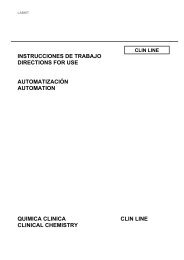
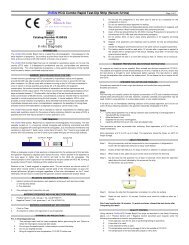


![[SAS-1 urine analysis]. - Agentúra Harmony vos](https://img.yumpu.com/47529787/1/185x260/sas-1-urine-analysis-agentara-harmony-vos.jpg?quality=85)


![[SAS-MX Acid Hb]. - Agentúra Harmony vos](https://img.yumpu.com/46129828/1/185x260/sas-mx-acid-hb-agentara-harmony-vos.jpg?quality=85)

